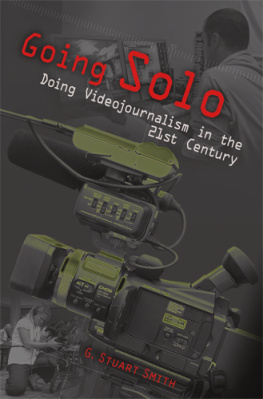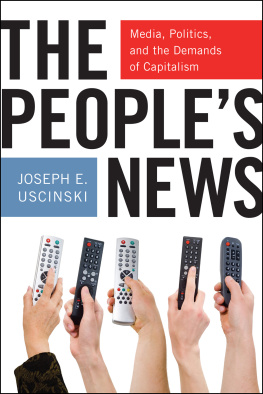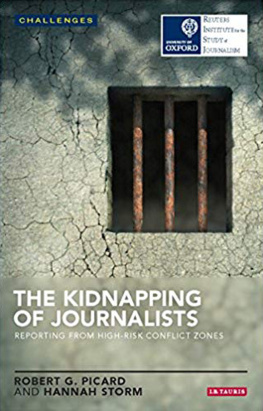Preface
Some of the best stuff I've ever written for TV, I composed while looking through the viewfinder of a camera. Some of the best stuff I've ever written for TV, I composed after logging video shot by an excellent photographer. Some of the bestand most gratifyingTV stories I ever told, I never wrote a word. I just let the pictures, sound, and people tell their stories.
I began my news career in radio, but always enjoyed photography, using my 35mm camera to explore the visual creativity that my radio job didn't allow.
When I moved to TV, my first joband probably best job I ever hadwas as a one-man band, shooting 16mm film in a bureau where I determined what stories to cover and when to do them. Even while working primarily as a reporter, I kept a hand in the videography side, sometimes picking up a Betacam to shoot stories by myself.
Like most journalists, there have been many stories in my career that were not fun, just hustling to get accurate information and get it out quickly to the audience. But there have been many occasions when the storytelling has been fun and creative as well. Those happened when I worked by myself as a one-man band and when I worked with a photographer. I know there are times when working alone has drawbacks; dividing the work can be productive; collaborating can be inspiring. There also are times when working alone has been more productive and fulfilling than waiting around for a photographer to get one more angle or coming to loggerheads over whether to use a particular shot in editing the story.
I have won awards for both TV reporting and news videography. I have produced newscasts; I have worked in news management and I have produced two documentaries working mostly as a solo videojournalist. As a journalismeducator I now have the luxury of time to study the industry. What I have witnessed is a trend toward more news operations utilizing what we used to call one-man bands and now call by a variety of names.
I know well the pros and cons of the arguments about one-man banding or solo videojournalism. I also know from experience what it takes to go solo, to produce a video news story on a deadline without the help of another person.
What I don't know, however, is exactly what to call the people who are at the heart of this growing phenomenon. One-man band is no longer in style, and there are now several titles that have been used to replace it. Depending on the corporate entity that employs them, they are called videojournalist, backpack journalist, digital journalist, or multimedia journalist.
What I have settled on is the term solo videojournalist. The word videojournalist is a combination, like the term photojournalist. Solo, obviously, implies someone who works alone, unlike a TV reporter and photographer team who work as a pair, but each is still, in his or her own right, a video journalist.
So, you will see the term solo videojournalist, VJ, or just plain videojournalist used throughout this book. It seems to be generic enough to cover the spectrum of companies that have adopted the concept in whatever nomenclature they use.
You will find while reading this book that VJs are making a difference in our news media. The concept truly has been born again to find a new life in television and online news media. What the genre lacks, however, is an instructional manual. There are many texts about reporting and volumes on videography. But, as far as I can tell, no single text has combined the skills into one that shows people how to master the unique requirements of each. Going Solo: Doing Videojournalism in the 21st Century attempts to do that.
Yet this book represents only a snapshot of the solo videojournalism genre in the early twenty-first century. I could not visit every newspaper, TV station, and Web operation that utilize VJs. While gathering information and writing this book, the field of solo videojournalism has been constantly evolving. Some of the things I first discovered no longer exist as they did before. I have made every effort to make sure that the book is as up-to-date as possible at the deadline.
One of the problems in doing this book in a timely way is that, as in all media jobs, people move on as better opportunities strike. So some of the people profiled no longer work at the organizations where I first met them. When I know of their departure, I have documented them either in the narrative or the endnotes.
Thanks to all who took time to help me do original research for the book. Those folks include Mike Sechrist, Steve Sabato, Melissa Penry, Jerry Barlar, Joe Gregory, and Matthew Zelkind at WKRN; Patti Dennis, Dan Weaver, and HeidiMcGuire at KUSA; and Dan Adams, formerly at KGTV. At newspaper Web operations, thanks to washingtonpost.com's Tom Kennedy, Chet Rhodes, Christina Pino-Marina, and Ben de la Cruz; at HamptonRoads.TV, Chris Kouba, Patrick Buchanan, Brian Clark, Audrey Esther, Craig Kimberly, and Les Robinson; at the Fort Myers News-Press, Kate Marymont, Cindy McCurry-Ross, Mackenzie Warren, Christine Lee, Jessie Vega, Marc Beaudin, Mark H. Bickel, Amy Sowder, and Jackie Winchester. Thanks also to Roger Richards formerly of the Norfolk Virginian-Pilot and multimedia journalist Angela Grant.
Thanks also to Hofstra University's School of Communication, which provided some faculty grants to help offset some of my travel expenses for the research. Finally, a big thanks to Pam Deitrich for support and advice as the book advanced through so many stages.
Chapter 1
A Rose by Any Other Name
When Barack Obama delivered his inaugural speech on January 20, 2009, millions of people watched on traditional TV and cable news channels. Millions more tuned in from work on their computers. But they didn't choose news text services. They went online to see the speech streamed online, setting a record for people tuning into Internet Web sites to watch video.
As President Obama delivered his speech, furloughs, downsizing, and resource sharing were the watchwords for many industries dealing with the deep recession. With technology advancing and more than two-thirds of Americans telling pollsters that traditional journalism sources are out of touch with what they want from news, unlike past recessions, this downturn had long-lasting effects, permanently changing the ways news media companies gather and disseminate information to the public.
The changes are going to be wrenching in the industry, says longtime magazine photojournalist and video convert Dirck Halstead.
Many newspapers cut the staff of their Washington bureaus.
One-man bands, long a niche in the TV news business, began moving to a mainstream position as more stations cut two-person crews and adopted VJs to cut costs. The solo videojournalist not only reports and writes stories, but also shoots video and edits them.







 This paper meets the requirements of the American National Standard for Permanence of Paper for Printed Library Materials, Z39.48, 1984.
This paper meets the requirements of the American National Standard for Permanence of Paper for Printed Library Materials, Z39.48, 1984.